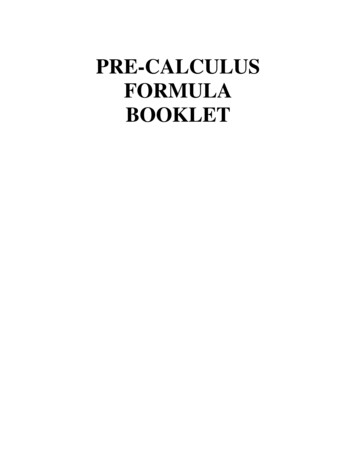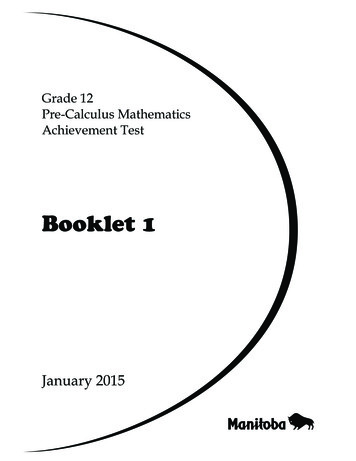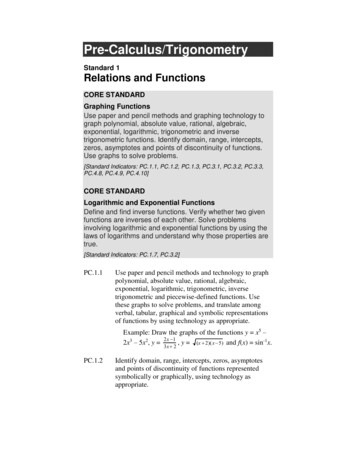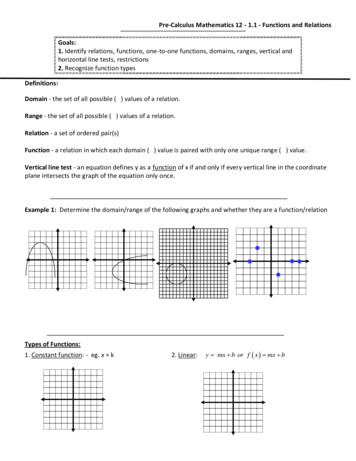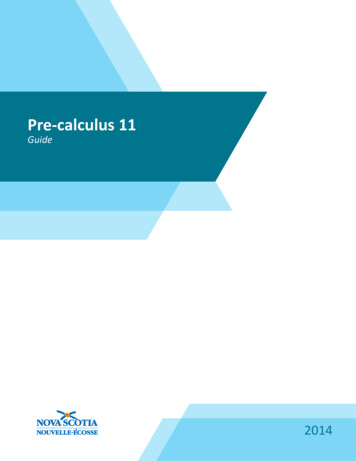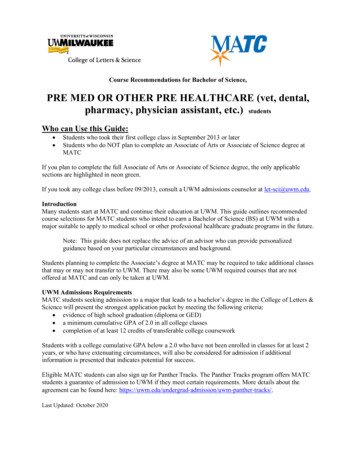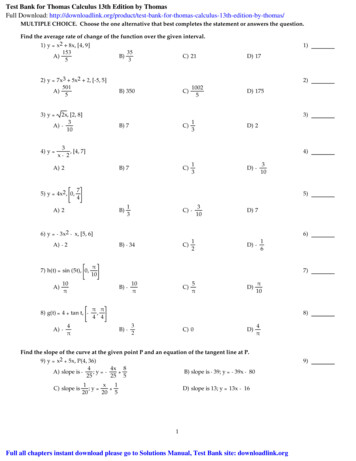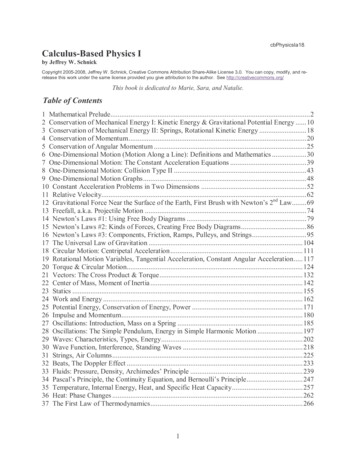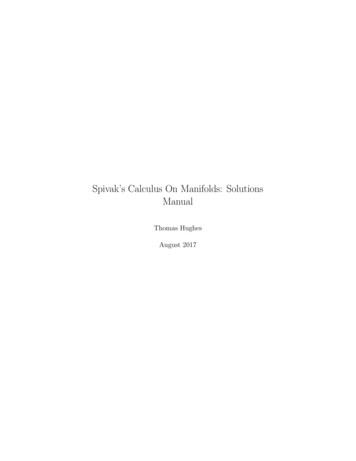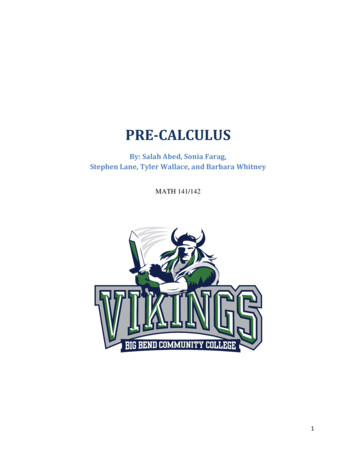
Transcription
PRE-CALCULUSBy: Salah Abed, Sonia Farag,Stephen Lane, Tyler Wallace, and Barbara WhitneyMATH 141/1421
Pre-Calculus by Abed, Farag, Lane, Wallace, and Whitney is licensed under the creativecommons attribution, noncommercial, share alike 3.0 unported (CC BY-NC-SA 3.0). Thismeans:You are free:To Share – to copy, distribute and transmit the workTo Remix – to adapt the workUnder the following conditions:Attribution – you must attribute the work in the manner specified by the author orlicensor (but not in any way that suggests that they endorse you or your use of the work)Noncommercial – you may not use this work for commercial purposes.Share Alike – If you alter, transform, or build upon this work, you may distribute theresulting work only under the same or similar license to this one.With the understanding that:Waiver – Any of the above conditions can be waived if you get permission from thecopyright holderPublic Domain – where the work or any of its elements is in the public domain underapplicable law, that status is in no way affected by the license.Other Rights – In no way are any of the following rights affected by the license: Your fair dealing or Fair Use rights, or other applicable copyright exceptions andlimitations;The author’s moral rights;Rights other persons may have either in the work itself or in how the work isused, such as publicity or privacy rightsNotice – For any reuse or distribution, you must make clear to others the license terms of thiswork. The best way to do this is with a link to ed.en USSelected exercises, examples, and lessons were remixed from PreCalculus: An Investigation ofFunctions by David Lippman and Melonie Rasmussen under a CC-BY-SA license.2
AcknowledgmentsWe would like to thank Big Bend Community College President, Dr. Terry Leas, the Board ofTrustees, Bill Autry and the rest of the Exceptional Faculty Award Committee at Big BendCommunity College for their generous support that made this text possible.Edits ByApril MayerSarah Adams3
Table of ContentsMATH 141 Pre-Calculus I1. College Algebra .61.1 Simplifying with Exponents .71.2 Radical Expressions and Equations .161.3 Quadratic Expressions and Equations .301.4 Simplifying Rational Expressions.471.5 Complex Numbers .581.6 Complete the Square .651.7 Solving Linear Formulas.691.8 Solving Absolute Value Equations and Inequalities.732. Functions and Graphs .792.1 Functions .802.2 Algebra of Functions.942.3 Inverse Functions .1012.4 Applications of Functions .1102.5 Reading Graphs of Functions.1202.6 Transformations of Graphs .1362.7 Transformations of Basic Functions .1423. Graphs of Key Functions .1543.1 Graphs of Polynomial Functions .1553.2 Synthetic Division .1633.3 Rational Root Theorem .1703.4 Graphs of Reciprocal Functions.1743.5 Graphs of Rational Functions .1783.6 Midpoint, Distance, and Circles.1864. Exponents and Logarithms .1934.1 Exponential Equations with Common Base .1944.2 Properties of Logarithms.2004.3 Exponential Equations with Different Bases .2074.4 Solving Equations with Logarithms.2114.5 Applications of Logarithms and Exponents .2204
MATH 142 Pre-Calculus II5. Trigonometry .2345.1 Angles .2345.2 Right Triangle Trigonometry .3475.3 Non-Right Triangles: Laws of Sines and Cosines .2555.4 Points on Circles .2725.5 Other Trigonometric Functions.2865.6 Graphs of Trig Functions .2955.7 Inverse Trig Functions .3186. Analytic Trigonometry.3246.1 Solving Trigonometric Equations .3256.2 Modeling with Trigonometric Functions .3336.3 Solving Trigonometric Equations with Identities .3446.4 Addition and Subtraction Identities .3516.5 Double Angle Identities .3666.6 Review Trig Identities and Trig Equations .3767. Polar Coordinates .3837.1 Polar Coordinates .3847.2 Polar Form of Complex Numbers .3987.3 DeMoivre’s Theorem .4068. Sequences and Series .4168.1 Sequences .4178.2 Series .4228.3 Arithmetic Series .4268.4 Geometric Series .4318.5 Mathematical Induction .438Selected Answers .4465
Chapter 1:College Algebra6
1.1 Simplifying with ExponentsExponential Notation:Let 𝑎 be a real number, variable, or algebraic expression, and let 𝑛 be a positive integer. Then𝑎𝑛 𝑎 𝑎 𝑎 𝑎𝑛 factorswhere 𝑛 is the exponent and 𝑎 is the base. The expression 𝑎𝑛 is read “𝑎 to the 𝑛-th power”.Properties of Exponents:Let 𝑎 and 𝑏 be real numbers, variables, or algebraic expressions, and let 𝑚 and 𝑛 be rationalnumbers (assume all denominators and bases are nonzero).Example070 1, ( 3) 13 5 111, ( 2) 3 53( 2)38Property𝑎0 1𝑎 𝑛 1𝑎𝑛32 33 3 3 3 3 3 35 243𝑎𝑚 𝑎𝑛 𝑎𝑚 𝑛(22 )4 (2 2)4 24 24 28 256(𝑎𝑚 )𝑛 𝑎𝑚𝑛(10)3 (2 5)3 23 53 8 125 1000(𝑎𝑏)𝑛 𝑎𝑛 𝑏 𝑛2 3 238( ) 3 3327𝑎 𝑛 𝑎𝑛( ) 𝑛𝑏𝑏27 27 3 24 16232311 7 3 4 1/167222𝑎𝑚if 𝑚 𝑛 then 𝑛 𝑎𝑚 𝑛𝑎𝑎𝑚1if 𝑚 𝑛 then 𝑛 𝑛 𝑚𝑎𝑎 323 411 34 34 813 2 3 3 12 128342 3 2 3 33 27( ) 3 3 3328𝑎 𝑚 𝑏 𝑛 𝑏 𝑛 𝑎𝑚𝑎 𝑛𝑏 𝑛( ) ( )𝑏𝑎7
Simplifying Expressions Containing Exponents:Use the properties of exponents to simplify each expression:Example 1: Simplify(4𝑥 3 𝑦 5 )(3𝑥 2 𝑦 4 )Rearrange factors(3)(4)𝑥 3 𝑥 2 𝑦 5 𝑦 4Multiply numbers, add exponents12𝑥 5 𝑦 9Final answerExample 2: Simplify(4𝑎2 𝑏 3 𝑐)1/2½ as exponent on each factor41/2 𝑎2/2 𝑏 3/2 𝑐 1/2Simplify, recall 41/2 4 22𝑎𝑏 3/2 𝑐1/2Final answerExample 3: Simplify82𝑟 25 3() ( 3)5𝑟3Exponents on numerator and denominator(2𝑟 2 )3 53 3 3(𝑟 )53Exponents on each factor in parentheses23 𝑟 6 53 53 𝑟 9Divide out the 53 , simplify 23 88𝑟 6𝑟9Subtract exponents, denominator is larger8𝑟3Final answer
Example 4: Simplify(𝑢 3 𝑣 2 ) 3Exponent on each factor in parentheses(𝑢 3 ) 3 (𝑣 2 ) 3𝑢9 𝑣 6𝑢9𝑣6Multiply exponentsMove negative exponentFinal answerExample 5: Simplify9𝑥 2 𝑦 43𝑥 1 𝑦 2Rearrange with negative exponents in one fraction9𝑥 2 𝑦 4 3𝑦 2 𝑥 1Move negative exponents and make positive9𝑥 2 𝑥1 3𝑦 2 𝑦 4Add exponent, reduce numbers3𝑥 3𝑦6Final answerExample 6: Simplify 1/3𝑢3( )8𝑣1/323 𝑣( 3)𝑢Factor 8 23 , negative exponent switches the fractionExponent on each factor in parentheses(23 )1/3 𝑣 1/3(𝑢3 )1/3Multiply exponents2𝑣 1/3𝑢Final answer9
Example 7: Simplify(2𝑥1/3 𝑦1/3 )(4𝑥 2/3 2𝑥1/3 𝑦 1/3 𝑦 2/3 )Multiply 2𝑥1/3 and 𝑦1/3by trinomial8𝑥 4𝑥 2/3 𝑦 1/3 2𝑥1/3 𝑦 2/3 4𝑥 2/3 𝑦1/3 2𝑥1/3 𝑦 2/3 𝑦Combine like terms8𝑥 𝑦Final answerExample 8: Simplify𝑥 𝑛 𝑥 3𝑛 1 (𝑥 2𝑛 3 )2Multiply exponent through parenthesis𝑥 𝑛 𝑥 3𝑛 1 𝑥 4𝑛 6Add exponents𝑥 8𝑛 5Final answerExample 9: Simplify(3𝑥 𝑘 3 )2𝑥 2(𝑘 1)𝑥𝑘 𝑘 3(𝑥 )32 𝑥 2𝑘 6 𝑥 𝑘 𝑥 2𝑘 2 𝑥 3𝑘Add exponents in numerator and denominator9𝑥 3𝑘 6𝑥 5𝑘 2Subtract exponents, denominator is larger9Final answer𝑥 2𝑘 410Multiply exponents through parenthesis
Example 10: Simplify 3 4𝑥 𝑎 3 𝑥 2𝑎[( 𝑏 ) ( 3𝑏 ) ]𝑦𝑦3 and 3 as exponents on each factor 4𝑥 3𝑎 𝑥 6𝑎[ 3𝑏 9𝑏 ]𝑦𝑦Add exponents 4 4 as exponent on each factor𝑥 3𝑎( 6𝑏 )𝑦𝑥 12𝑎𝑦 24𝑏Final answerExample 11:1Subtract exponents𝑥 4𝑘 1 𝑦 𝑘 1 3𝑘( 2𝑘 1 10𝑘 1 )𝑥𝑦1(𝑥 6𝑘 𝑦 9𝑘 )1/3𝑘3𝑘𝑥2𝑦3as exponent on each factorFinal answerExample 12:𝑛𝑥1/2𝑛 𝑥1/6𝑛 2( 1/3𝑛 )𝑥2/3𝑛𝑛2𝑥( 1/3𝑛 )𝑥(𝑥 1/𝑛 )𝑛/2𝑥1/2Add exponents in numeratorSubtract exponents in denominator𝑛2as exponent on the factorFinal answer11
Example 13:2𝑘 1 𝑘 1𝑘3(𝑘 1) 3 3𝑘 2𝑥𝑦𝑥𝑦( 3𝑘 1 1 𝑘 ) ( 3(𝑘 1) 3𝑘 )𝑥𝑦𝑥𝑦Distribute through parenthesis in exponents𝑘Subtract exponents𝑥 2𝑘 1 𝑦 𝑘 1𝑥 3𝑘 3 𝑦 3 3𝑘 2( 3𝑘 1 1 𝑘 ) ( 3𝑘 3 3𝑘 )𝑥𝑦𝑥𝑦𝑦 2𝑘( 𝑘 ) (𝑥 6 𝑦 3 )𝑘/2𝑥12𝑘2as exponent on each factor𝑦 2𝑘( 𝑘 ) (𝑥 3𝑘 𝑦 3𝑘/2 )𝑥Multiply by reciprocal𝑦 2𝑘1( 𝑘 ) ( 3𝑘 3𝑘/2 )𝑥𝑥 𝑦Add exponents for multiplying,subtract exponents for dividing𝑦 𝑘/2𝑥 4𝑘Final answer
1.1 Simplifying with Exponents PracticeSimplify the following expressions1.( 3𝑥 3 𝑦 2 𝑧) 23.1262.( 5𝑥 7/4 𝑦 2/3 )𝑥 2 𝑦 6()94.𝑎 2/3 𝑏1/25.9 3/2 33 ( ) 4 81 243 1/546.(4𝑚2 𝑛1/2 𝑟)( 2𝑚𝑛2/3 𝑟 1 )7.(8𝑥 3 𝑦 3/2 )2/38.𝑥 1 𝑦𝑥 3( 1/2 2/3 ) ( 1 )𝑦𝑥 𝑦9.𝑧 2/3( 1 1/3 )5 𝑧 210.(3𝑎2 𝑏 2/3 𝑐 3 )( 2𝑎5 𝑏1/3 𝑐 2 )11.𝑎1/2 𝑏 2/3( 1 2 )2 𝑐612.13.(125𝑥 2 𝑦 1/3 𝑎)15.𝑚2 𝑝()64𝑚 3 𝑝1/317.9𝑥1/3 𝑥1/2( 1/6 )𝑥19.𝑥 3/4 𝑦 3/2( 1/4 3/2 )𝑥𝑦21.23. 1/23𝑏 2/3 𝑎2/3 1/22 5/2( 4𝑥 𝑦𝑥 1 𝑦 1/2)() 21/214.3𝑥 2/3 𝑦 316𝑥 4 𝑦 5( 5/2 3 ) ( 2 4 )𝑥 𝑧2𝑥 𝑧16.8𝑦1/3 𝑦 1/4()𝑦 1/1218.16𝑥1/3 𝑦 2/3( 2/3 1/3 )9𝑥𝑦20.𝑥 𝑘 𝑥 2𝑘 1 (𝑥 3𝑘 2 )2(𝑥 3𝑘 2 𝑥 4𝑘 3 )2𝑥14𝑘22.(𝑎𝑘 𝑏 𝑘 1 )2(𝑎2 𝑘 𝑏 3 𝑘 )2(𝑥 2𝑘 3 𝑦 3𝑘 11 )3(𝑥 𝑘 1 𝑦 𝑘 4 )624.𝑥 2𝑛 3 𝑥 𝑛 5 𝑥 3𝑛 1 𝑥 𝑛 2( 2𝑥𝑦1/6 𝑎 2/3 ) 1/31/21/23/2𝑥 1/2 𝑦 1/2 ( 1/2 3/2 )𝑥 𝑦23/2 2/38𝑥 3/2 𝑦 3/2()27𝑥1/2 𝑦 5/213
25.(2𝑥 𝑛 1 )2 𝑥 3 𝑛 𝑥 2(𝑛 1) (𝑥 𝑛 )226.(𝑐 𝑛 𝑘 3𝑛 )(𝑐 2𝑛 𝑐 𝑛 𝑘 3𝑛 𝑘 6𝑛 )27.(3𝑥 𝑛 1 )228.𝑎6𝑛 1 𝑏 5𝑛 2𝑎6𝑛 1 𝑏 5𝑛 2𝑥 2(𝑛 1)𝑥𝑛 𝑛 3(𝑥 )29.(3𝑎𝑘 𝑏 4𝑘 )3(5𝑎𝑘 1 𝑏 2𝑘 1 )230.𝑎2𝑛 𝑎𝑛 131.(𝑎𝑛 1)(𝑎2𝑛 1)32.(𝑥 𝑛 1)233.𝑥 2𝑛 1𝑥𝑛𝑦34.(𝑥 𝑎 𝑦 𝑏 𝑥 𝑏 𝑦 𝑎 )𝑐35.(𝑚 𝑥 𝑏 𝑛 𝑥 𝑏 )𝑥 (𝑚𝑏 𝑛 𝑏 )𝑥36.(3𝑥 𝑎 𝑦 𝑏 )3[]( 3𝑥 𝑎 𝑦 𝑏 )237.𝑥 𝑟 2 𝑥 2𝑟[( 𝑡 ) ( 4𝑡 ) ]𝑦𝑦38.𝑥 5𝑛 1 𝑦 𝑛 1 2𝑛( 3𝑛 1 5𝑛 1 )𝑥𝑦39.𝑎 4(𝑛 2) 𝑏 3𝑛 6 3𝑛( (2𝑛 8) 3(𝑛 2) )𝑎𝑏40.𝑦 1/3𝑛 𝑦 1/4𝑛()𝑦 1/12𝑛41.𝑥1/3𝑛 𝑥1/2𝑛 2( 1/6𝑛 )𝑥42.𝑥 2𝑛 1 𝑦 3 𝑛 𝑛( 3𝑛 1 3 2𝑛 )𝑥𝑦43.𝑥 2(𝑛 1) 𝑦 3 𝑛 𝑛( 3𝑛 2 3 2𝑛 )𝑥𝑦44.𝑥 2(2𝑛 1) 𝑦 2 𝑛( 2(𝑛 1) 2 𝑛 )𝑥𝑦45.𝑥 2𝑛 1 𝑦 𝑛 1𝑥 𝑛 1 𝑦1 𝑛 ()𝑥 3𝑛 1 𝑦 1 𝑛𝑥 𝑛 1 𝑦 𝑛47.(𝑥1/3 𝑦1/3 )(𝑥 2/3 𝑥1/3 𝑦 1/3 𝑦 2/3 )48.(𝑥1/3 𝑦1/3 )(𝑥 2/3 𝑥1/3 𝑦 1/3 𝑦 2/3 )49.(𝑥1/2 4𝑥1/4 4)(𝑥1/2 4𝑥1/4 4)50.(𝑥1/2 2𝑥1/4 𝑦1/4 𝑦 1/2 )(𝑥1/2 2𝑥1/4 𝑦 1/4 𝑦1/2 )14 2 31𝑛2𝑛46.212𝑛1 2𝑛 1 𝑛 112𝑛2(𝑛 1) 2(1 𝑛) 2𝑥𝑦𝑥𝑦( 3𝑛 1 1 𝑛 ) ( 2(𝑛 1) 2𝑛 )𝑥𝑦𝑥𝑦
51.(𝑥1/2 2𝑥1/4 𝑦1/4 𝑦 1/2 )(𝑥1/2 2𝑥1/4 𝑦 1/4 𝑦1/2 )52.(𝑥1/2 2𝑥1/4 𝑦1/4 2𝑦1/2 )(𝑥1/2 2𝑥1/4 𝑦1/4 2𝑦1/2 )53.(𝑥 𝑦)(𝑥 𝑛 1 𝑥 𝑛 2 𝑦 𝑥 𝑛 3 𝑦 2 𝑥 3 𝑦 𝑛 4 𝑥 2 𝑦 𝑛 3 𝑥𝑦 𝑛 2 𝑦 𝑛 1 )15
1.2 Radical Expressions and Equations𝒏Principle 𝒏-th root 𝒂:Let 𝑛 be a positive integer greater than 1, and let 𝑎 be a real number.𝑛(1) If 𝑎 0 then 𝑎 0𝑛(2) If 𝑎 0 then 𝑎 is the positive real number 𝑏 such that 𝑏 𝑛 𝑎𝑛(3) (a) If 𝑎 0 and 𝑛 is odd, then 𝑎 is the negative real number 𝑏 such that 𝑏 𝑛 𝑎𝑛(b) If 𝑎 0 and 𝑛 is even, then 𝑎 is not a real number.𝑛The expression 𝑎 is a radical, the number 𝑎 is the radicand, and 𝑛 is the index of the radical.The symbol is called a radical sign.3If 𝑎 𝑏, then 𝑏 2 𝑎. If 𝑎 𝑏, then 𝑏 3 𝑎𝒏Properties of 𝒂: (where 𝑛 is a positive integer)Example233( 7) 7, ( 5) 5Property𝑛( 𝑎 ) 𝑎 if 𝑎 is a real number𝑛𝑛𝑛3 𝑎𝑛 𝑎 if 𝑎 0 32 3, 23 23𝑛5 𝑎𝑛 𝑎 if 𝑎 0 and 𝑛 is odd ( 2)3 2, ( 3)5 34 ( 2)2 2 2, ( 3)4 3 3𝑛 𝑎𝑛 𝑎 if 𝑎 0 and 𝑛 is even 𝑥 2 𝑥 { 𝑥 if 𝑥 0 𝑥 if 𝑥 016
Laws of Radicals:Example 98 49 2 49 2 7 233333 54 ( 27)(2) 27 2 3 23 3 64 (2)(3)𝑛𝑎 𝑎 𝑛𝑏 𝑏3𝑛3 3 3 3 8 823Law𝑛 𝑎𝑏 𝑛 𝑎 𝑏𝑛66 64 64 26 2𝑚 𝑛 𝑎 𝑚𝑛 𝑎Warning: If 𝑎 0 and 𝑏 0Warning 𝑎2 𝑏2 𝑎 𝑏 𝑎 𝑏 𝑎 𝑏Example 32 42 25 5 3 4 7 4 9 13 4 9 2 3 5Simplifying RadicalsAn expression involving radicals is in simplest form when the following conditions are satisfied:1. All possible factors have been removed from the radical2. All fractions have radical-free denominators (accomplished by a process calledrationalizing the denominator)3. The index of the radical is reduced.To simplify a radical, we factor the radicand into factors whose exponents are multiples of theindex. The roots of these factors are written outside the radical and the “leftover” factors makeup the new radicand.17
Example 1: Simplify3 135Factor 135 27 5Split into two radicals333 33 533 5Simplify the first radicalFinal answerExample 2: Simplify3 16𝑎3 𝑏 8 𝑐 4Factor into multiples of the index (23 𝑎3 𝑏 6 𝑐 3 )(2𝑏 2 𝑐)Divide a 3 (the index) out of each exponent33 (2𝑎𝑏 2 𝑐)3 (2𝑏 2 𝑐)33Split into two radicals (2𝑎𝑏 2 𝑐)3 2𝑏 2 𝑐Simplify first radical3Final answer2𝑎𝑏 2 𝑐 2𝑏 2 𝑐Example 3: Simplify18 3𝑥 2 𝑦 3 6𝑥 5 𝑦Multiply radicals together, factor the 6 3𝑥 2 𝑦 3 2 3𝑥 5 𝑦Combine bases 32 2𝑥 7 𝑦 4Factor into multiples of the index (32 𝑥 6 𝑦 4 )(2𝑥)Divide a 2 (the index) out of each exponent (3𝑥 3 𝑦 2 )2 (2𝑥)Split into two radicals (3𝑥 3 𝑦 2 )2 2𝑥Simplify the first radical3𝑥 3 𝑦 2 2𝑥Final answer
Rationalizing Denominators of Quotients (𝑎 0)Factor indenominator 𝑥3 𝑥7 𝑥 3Multiply numeratorand denominator by 𝑥Resulting factor 𝑥 𝑥 𝑥 2 𝑥33 𝑥 23 𝑥 𝑥 2 𝑥777 𝑥 3 𝑥 4 𝑥 𝑥 4Example 4: Simplify1Multiply numerator and denominator by 3 31 3( ) 3 3Multiply 3Simplify denominator 32 33Final answerExample 5: Simplify133Multiply numerator and denominator by 𝑎2 𝑎3Multiply 𝑎2Simplify denominator 𝑎2()33 𝑎 𝑎2133 𝑎33 𝑎2𝑎Final answer19
Example 6: Simplify3 2Square root of numerator and denominator 3Multiply numerator and denominator by 2 2 3 2( ) 2 2Multiply 6Simplify denominator 22 62Final answerExample 7: Simplify5 𝑥𝑦25 𝑥Take root of numerator and denominator5Multiply numerator and denominator by 𝑦 35 𝑦 255 𝑦 3()55 𝑦 2 𝑦 3 𝑥5 𝑥𝑦 3MultiplySimplify denominator5 𝑦 55 𝑥𝑦 3𝑦20Final answer
Definition of Rational Exponents:Let𝑚𝑛be a rational number where 𝑛 is a positive integer greater than 1. If 𝑎 is a real number such𝑛that 𝑎 exists, then𝑛(1) 𝑎1/𝑛 𝑎𝑛𝑛(2) 𝑎𝑚/𝑛 𝑎𝑚 ( 𝑎)𝑚𝑚(3) 𝑎𝑚/𝑛 (𝑎1/𝑛 ) (𝑎𝑚 )1/𝑛Example 8: Simplify( 125)2/3 (4) 5/223( ( 5)3 ) ( 4)Convert to radicals 5Take roots( 5)2 (2) 5Move negative exponent and make it positive( 5)225Evaluate exponents2532Final answerExample 9: Simplify(𝑎2 𝑏 9 )1/3Put exponent on each factor(𝑎2 )1/3 (𝑏 9 )1/3Multiply exponents𝑎2/3 𝑏 3Final answer21
Example 10: Simplify22𝑥 2/33𝑥 1/6( 1/2 ) ( 1/3 )𝑦𝑦Put exponent on each factor, squaring 2 to get 44𝑥 4/3 3𝑥 1/6() ( 1/3 )𝑦𝑦Multiply bases, add exponents(4 3)𝑥 4/3 1/6𝑦1 1/3Common denominators on exponents12𝑥 8/6 1/6𝑦 3/3 1/3Add exponents12𝑥 7/6𝑦 4/3Final answerAddition and Subtraction with RadicalsWe add or subtract radicals just as we add or subtract like termsExample 11: Add7 5 3 5Add like radicals, radical remains unchanged10 5Final answerExample 12: Add3339 2 7𝑥 2 4 23313 2 7𝑥 23Add like radicals, note 7𝑥 2 is not like othersFinal answerExample 13: Add5538 4𝑥 2 4𝑥 4𝑥5310 4𝑥 4𝑥22Add like radicals, note index must matchFinal answer
Example 14: Add35 16𝑦 4 7𝑦 3 2𝑦3Factor first radical5 23 𝑦 3 3 2𝑦 7𝑦 3 2𝑦Simplify first radical5 2𝑦 3 2𝑦 7𝑦 3 2𝑦Multiply10𝑦 3 2𝑦 7𝑦 3 2𝑦Add like terms17𝑦 3 2𝑦Final answerRadical EquationsThe principle of powers: If an equation 𝑎 𝑏 is true, then 𝑎𝑛 𝑏 𝑛 is true for any rationalnumber 𝑛 for which 𝑎𝑛 and 𝑏 𝑛 exist. This means we will have to check our solutions in theoriginal equation to be sure they work. If a value does not work it is called an extraneoussolution and not included in the final answerExample 15: Solve 5𝑥 3 7Square both sides5𝑥 3 49Subtract 3 from both sides5𝑥 46Divide both sides by 5𝑥 465Check solution46 5 ( ) 3 75 46 3 7 49 77 7𝑥 465It works!Final answer23
Example 16: Solve 4𝑥 9 2𝑥 0Add 2𝑥 to isolate one radical term 4𝑥 9 2𝑥Square both sides4𝑥 9 2𝑥Subtract 2𝑥 and add 9 to both sides2𝑥 9Divide by 2𝑥 92Check solution99 4 ( ) 9 2 ( ) 022 18 9 9 0 9 3 03 3 00 0𝑥 2492It works!Final answer
Example 17: Solve 3 𝑥 𝑥 3Add 𝑥 to isolate the radical 3 𝑥 𝑥 3Square both sides3 𝑥 𝑥 2 6𝑥 9Subtract 3 and add 𝑥0 𝑥 2 7𝑥 6Factor0 (𝑥 6)(𝑥 1)Set each factor equal to zero𝑥 6 0or𝑥 1 0Solve both equations𝑥 6, 1Check both solutions 3 ( 6) ( 6) 3 9 6 33 6 39 3Checking 𝑥 6Extraneous solution, not included in final answer 3 ( 1) ( 1) 3 4 1 32 1 33 3Checking 𝑥 1𝑥 1Final answerIt works!25
Example 18: Solve 4𝑦 1 𝑦 2 3Adding 𝑦 2 isolates one of the radical terms 4𝑦 1 3 𝑦 2Square both sides2( 4𝑦 1) (3 𝑦 2)Simplify, recall (𝑎 𝑏)2 𝑎2 2𝑎𝑏 𝑏 24𝑦 1 9 6 𝑦 2 𝑦 2Combine like terms4𝑦 1 7 𝑦 6 𝑦 2Subtract 7 and y to isolate the term with radical3𝑦 6 6 𝑦 2Divide by common factor of 3𝑦 2 2 𝑦 2Square both sides(𝑦 2)2 (2 𝑦 2)2622Simplify, recall (𝑎 𝑏)2 𝑎2 2𝑎𝑏 𝑏 2𝑦 2 4𝑦 4 4(𝑦 2)Distribute𝑦 2 4𝑦 4 4𝑦 8Subtract 4y, add 8 to make equal to zero𝑦 2 8𝑦 12 0Factor(𝑦 6)(𝑦 2) 0Set each factor equal to zero𝑦 6 0 or 𝑦 2 0Solve𝑦 6,2We need to check these answers 4(6) 1 (6) 2 3 24 1 6 2 3 25 4 35 2 33 3Checking 𝑦 6 4(2) 1 (2) 2 3 8 1 2 2 3 9 0 33 0 33 3𝑦 6,2Checking 𝑦 2It works!It works!Final answer
1.2 Radical Expressions and Equations PracticeSimplify each expression.1. 50 2 82. 63 2 7 273.2 2 54 2504.𝑥 2𝑥 4 18𝑥 35.1 826.1 48 2 37. 75 4 18 2 12 2 88.3 2𝑎3 𝑎 18𝑎 2 8𝑎39. 125 2 27 20 3 1210.12 12𝑥 3 𝑥311. 3𝑎 5 27𝑎3 𝑎 3𝑎12.1 3 27 2 12313.3 5 60 3 15514.3 50 4 8 27 315. 𝑥 4 𝑦 𝑥 9𝑥 2 𝑦 𝑥 2 16𝑦16.𝑎2 8𝑎3 𝑏 2𝑎3 18𝑎𝑏 3𝑎 50𝑎5 𝑏17. 16𝑎𝑏 3 9𝑎𝑏 3 25𝑎3 𝑏 318.95 25𝑥 𝑥𝑥 𝑥19.12 32 2920.712 189321.1 3 1 1 7 752 4 2 322.15 2 4 25 125 17 ( ) 5416333127
23.25.27.29.24.326 24 3 234 36 8(4) 3/2322 27 ( ) 2𝑥1 𝑥 𝑥 𝑥452 60326.4 9 28.4134 144 3 9 5 48 430.5 3 1 410032.33.231 241/2 481/332 634.𝑏𝑎3 𝑏𝑎2 𝑎435.𝑎 𝑏𝑎 𝑏 𝑎 𝑏𝑎 𝑏36.𝑎 111 1 2 1 2 (𝑎 ) ( )𝑎 1𝑎𝑎 𝑎3 431.337. 1 38.661 18 121/23 31 33 2 54 250 24 93𝑥𝑦 2 𝑥𝑦 2 𝑦𝑦2 3𝑥 2 𝑦 3 12𝑥 3 𝑦 27𝑥 5 𝑦 75𝑦39.1 1 18 108 121/2 33/2 5 33 6 340.1 12 2 25 24 6 96 66 6 23 5 641.51171 3(8)2/3 43 27 ( 27)2/3 1474 3263286
Solve each equation.42. 7𝑥 2 443. 2𝑥 3 3 044. 3𝑥 12 6 045. 5𝑥 1 4 046. 3𝑥 8 𝑥 047. 6𝑥 5 𝑥 048. 5𝑥 1 1 𝑥49. 𝑥 2 𝑥 250.𝑥 4𝑥 1 551.3 𝑥 6𝑥 1352. 5𝑥 1 4𝑥 4 053.𝑥 1 7 𝑥54. 6𝑥 8 3𝑥 4 055. 3 3𝑥 1 2𝑥56. 2𝑥 1 𝑥 157. 2𝑥 2 3 2𝑥 158. 3𝑥 2 𝑥 259. 4𝑥 5 𝑥 4 260. 3𝑥 1 4 𝑥 361. 3𝑥 4 𝑥 2 262. 𝑥 2 5 3𝑥 363. 2𝑥 4 𝑥 3 164. 4𝑥 4 𝑥 2 2𝑥 365. 3𝑥 4 2𝑥 1 𝑥 366. 4𝑥 1 𝑥 1 7𝑥 267. 2𝑥 1 𝑥 1 𝑥68. 6𝑥 2 2𝑥 6 15𝑥 1729
1.3 Quadratic Expressions and EquationsAlgebraic ExpressionsIt is convenient to use letters such as 𝑥 or 𝑦 to represent numbers. Such a symbol is called avariable. An algebraic expression is the result of performing a finite number of additions,subtractions, multiplications, divisions, or roots on a collection of variables and real numbers.The following are examples of algebraic expressions:𝑥 3 3𝑥 2 𝑥 𝜋,4𝑥𝑦 𝑥,𝑥 𝑦3 7𝑥 3 𝑧𝑥 5 𝑦 2PolynomialsIf 𝑥 is a variable, then a monomial in 𝑥 is an expression of the form 𝑎𝑥 𝑛 , where 𝑎 is a realnumber and 𝑛 is a nonnegative integer. A binomial is a sum of two monomials, and a trinomial isa sum of three monomials.Definition of a polynomial:A polynomial in 𝑥 is the sum of the form:𝑎𝑛 𝑥 𝑛 𝑎𝑛 1 𝑥 𝑛 1 𝑎1 𝑥 𝑎0Where 𝑛 is a nonnegative integer and each coefficient 𝑎 is a real number. If 𝑎𝑛 0, then thepolynomial is said to have degree 𝑛. Each expression 𝑎𝑘 𝑥 𝑘 in the sum is a term of thepolynomial. The coefficient 𝑎𝑘 of the highest power of 𝑥 is called the leading coefficient of thepolynomial.Example2𝑥 3𝑥 4 ( 7)𝑥 3Leading Coefficient2Degree5𝑥 7 8𝑥 2 ( 3)𝑥17 5𝑥 2 1 52880530
Example 1: Add(𝑥 3 4𝑥 2 5𝑥 9) (2𝑥 3 𝑥 2 3𝑥)Distribute “ ”𝑥 3 4𝑥 2 5𝑥 9 2𝑥 3 𝑥 2 3𝑥Combine like terms3𝑥 3 3𝑥 2 2𝑥 9Final answer(𝑥 3 5𝑥 2 10𝑥 6) (2𝑥 3 3𝑥 4)Distribute “ “𝑥 3 5𝑥 2 10𝑥 6 2𝑥 3 3𝑥 4Combine like terms 𝑥 3 5𝑥 2 7𝑥 10Final answerExample 2: SubtractExample 3: Multiply(7𝑥 5𝑦)(3𝑥 2𝑦)Use FOIL to multiply(7𝑥)(3𝑥) 21𝑥 2F – First terms(7𝑥)( 2𝑦) 14𝑥𝑦O – Outside terms(5𝑦)(3𝑥) 15𝑥𝑦I – Inside terms(5𝑦)( 2𝑦) 10𝑦 2L – Last terms21𝑥 2 14𝑥𝑦 15𝑥𝑦 10𝑦 2Combine like terms21𝑥 2 𝑥𝑦 10𝑦 2Final answerExample 4: Multiply(3𝑥 7)(2𝑥 3 3𝑥 1)(3𝑥)(2𝑥 3 ) (3𝑥)(3𝑥) (3𝑥)( 1) ( 7)(2𝑥 3 ) ( 7)(3𝑥) ( 7)( 1)6𝑥 4 9𝑥 2 3𝑥 14𝑥 3 21𝑥 76𝑥 4 14𝑥 3 9𝑥 2 24𝑥 7Distribute3𝑥 and 7MultiplyCombinelike termsFinal answerSpecial ProductsCertain products of binomials occur so frequently that you should learn to recognize them31
Special Product/Factor Formulas:NameDifference of two squaresProperty(𝑎 𝑏)(𝑎 𝑏) 𝑎2 𝑏 2𝑎2 𝑏 2 𝑃𝑟𝑖𝑚𝑒Sum of squares(𝑎 𝑏)2 𝑎2 2𝑎𝑏 𝑏 2(𝑎 𝑏)2 𝑎2 2𝑎𝑏 𝑏 2Perfect square trinomialSum of cubes(𝑎 𝑏)(𝑎2 𝑎𝑏 𝑏 2 ) 𝑎3 𝑏 3Difference of cubes(𝑎 𝑏)(𝑎2 𝑎𝑏 𝑏 2 ) 𝑎3 𝑏 3Binomial cubes(𝑎 𝑏)3 𝑎3 3𝑎2 𝑏 3𝑎𝑏 2 𝑏 3(𝑎 𝑏)3 𝑎3 3𝑎2 𝑏 3𝑎𝑏 2 𝑏 3Example 5: Find the product(2𝑥 3)2Use perfect square formula(2𝑥)2 2(2𝑥)(3) (3)2Simplify each term4𝑥 2 12𝑥 9Final answerExample 6: Find the product(2𝑥 𝑦)(2𝑥 𝑦)(4𝑥 2 𝑦 2 )(4𝑥 2 𝑦 2 )(4𝑥 2 𝑦 2 )16𝑥 4 𝑦 4Multiply first two binomials withdifference of squares formulaMultiply solution by last binomial withdifference of squares formulaFinal answerFactoring PolynomialsTo factor a polynomial means to do the reverse of multiplying, that is to find an equivalentexpression that is a product. Factoring is an important algebraic skill and in this section we studythe types of factorization that will commonly arise in your study of mathematics.Terms with common factors:When factoring, you should always look for factors common to all the terms of an expression.32
Example 7: Factor4𝑦 2𝑛 8Factor out common factor of 44(𝑦 2𝑛 2)Final answerExample 8: Factor5𝑥 4𝑛 20𝑥 3𝑛Factor out common factor of 5𝑥 3𝑛5𝑥 3𝑛 (𝑥 𝑛 4)Final answerExample 9: Factor8𝑝5𝑛 𝑞 2𝑛 4𝑝4𝑛 𝑞 3𝑛 2𝑝4𝑛 𝑞 4𝑛Factor out common factor of 2𝑝4𝑛 𝑞 2𝑛2𝑝4𝑛 𝑞 2𝑛 (4𝑝𝑛 2𝑞 𝑛 𝑞 2𝑛 )Final answerFactor by groupingIn more complicated expressions, there may be a common binomial factorExample 10: Factor(𝑎 𝑏)(𝑥 7) (𝑎 𝑏)(𝑥 𝑦 2 )Factor out common binomial factor of (𝑎 𝑏)(𝑎 𝑏)[(𝑥 7) (𝑥 𝑦 2 )]Combine like terms in second factor(𝑎 𝑏)(2𝑥 7 𝑦 2 )Final answerExample 11: Factor𝑎𝑥 2 𝑎 𝑥 2 1Factor GCF out of first and second group𝑎(𝑥 2 1) 1(𝑥 2 1)Factor common binomial factor(𝑥 2 1)(𝑎 1)Factor difference of squares(𝑥 1)(𝑥 1)(𝑎 1)Final answer33
Factor difference of squaresExample 12: Factor25𝑥 2𝑛 49𝑦 2𝑛Use difference of squares formula(5𝑥 𝑛 7𝑦 𝑛 )(5𝑥 𝑛 7𝑦 𝑛 )Final answerExample 13: Factor(𝑟 3)2 (𝑠 3)2Difference of squares on groups[(𝑟 3) (𝑠 3)][(𝑟 3) (𝑠 3)]Distribute negative through parentheses(𝑟 3 𝑠 3)(𝑟 3 𝑠 3)Combine like terms in each factor(𝑟 𝑠 6)(𝑟 𝑠)Final answerExample 14: Factor81𝑥 4 (𝑦 3𝑧)2Difference of squares formula[9𝑥 2 (𝑦 3𝑧)][9𝑥 2 (𝑦 3𝑧)]Distribute negative through parentheses(9𝑥 2 𝑦 3𝑧)(9𝑥 2 𝑦 3𝑧)Final answerFactor sum and difference of two cubesExample 15: Factor𝑢3 8𝑣 3Sum of cubes formula(𝑢 2𝑣)(𝑢2 2𝑢𝑣 (2𝑣)2 )Simplify(𝑢 2𝑣)(𝑢2 2𝑢𝑣 4𝑣 2 )Final answerExample 16: Factor:3464𝑐 3 27𝑑6Identify cube roots(4𝑐)3 (3𝑑 2 )3Difference of cubes formula(4𝑐 3𝑑2 )((4𝑐)2 (4𝑐)(3𝑑 2 ) (3𝑑)2 )Simplify(4𝑐 3𝑑2 )(16𝑐 2 12𝑐𝑑 2 9𝑑 4 )Final answer
Factor trinomialsA factorization of a trinomial 𝑝𝑥 2 𝑞𝑥 𝑟 (also called quadratic expression) where 𝑝 and 𝑞 areintegers, must be of the form𝑝𝑥 2 𝑞𝑥 𝑟 (𝑎𝑥 𝑏)(𝑐𝑥 𝑑)Where 𝑎, 𝑏, 𝑐, and 𝑑 are integers. It falls that 𝑎𝑐 𝑝, 𝑏𝑑 𝑟, and 𝑎𝑑 𝑏𝑐 𝑞. Only a limitednumber of choices for 𝑎, 𝑏, 𝑐, and 𝑑 satisfy these conditions. If none of the choices work, then𝑝𝑥 2 𝑞𝑥 𝑟 is irreducible. Trying the various possibilities, as we will see in the next example,is called the method of trial and error. This method is also applicable to trinomials of the form𝑝𝑥 2 𝑞𝑥𝑦 𝑟𝑦 2 , in which case the factorization must be of the form(𝑎𝑥 𝑏𝑦)(𝑐𝑥 𝑑𝑦).Example 17: Factor6𝑥 2 7𝑥 20Identify relationshipsof (𝑎𝑥 𝑏)(𝑐𝑥 𝑑)Assume 𝑎 and 𝑐 are both positive,consider possible combinationsfor each𝑎𝑐 6𝑏𝑑 20𝑎𝑑 𝑏𝑐 7𝑎𝑐166123This gives the following possibilities326𝑥 2 7𝑥 20 (𝑥 𝑏)(6𝑥 𝑑)6𝑥 2 7𝑥 20 (6𝑥 𝑏)(𝑥 𝑑)6𝑥 2 7𝑥 20 (3𝑥 𝑏)(2𝑥 𝑑)6𝑥 2 7𝑥 20 (2𝑥 𝑏)(3𝑥 𝑑)𝑏𝑑1 20 1202 10 2104 5(3𝑥 4)(2𝑥 5) 4 5 55 4 4Next consider possible values for𝑏 and 𝑑, as 𝑏𝑑 20 we list possiblecombinationsTrying various values we find𝑏 4, 𝑑 5, 𝑎 3, and 𝑐 2Final answerAs a check, you should multiply the final factorization to see whether the original polynomial isobtained.35
Factoring with GCFExample 18: Factor 2𝑥 2 4𝑥 2𝑥 3Reorder2𝑥 3 2𝑥 2 4𝑥Factor GCF of 2𝑥2𝑥(𝑥 2 𝑥 2)Factor trinomial2𝑥(𝑥 2)(𝑥 1)Final answerExample 19: Factor2𝑥 2 20𝑥 50Factor GCF of 22(𝑥 2 10𝑥 25)Note form of perfect square trinomial2(𝑥 2 2(5)(𝑥) 52 )Perfect square formula2(𝑥 5)2Final answerExample 20: Factor63 2𝑥 𝑛 𝑥 2𝑛Product 𝑎𝑐 63( 9)(7) 63Sum 𝑏 2 9 7 2Using the 𝑎𝑐 method, split middle termSplit middle term using 9 and 763 9𝑥 𝑛 7𝑥 𝑛 𝑥 2𝑛Factor by grouping9(7 𝑥 𝑛 ) 𝑥 𝑛 (7 𝑥 𝑛 )Factor binomial GCF(7 𝑥 𝑛 )(9 𝑥 𝑛 )Final answerSolving Quadratic EquationsDefinition of a Quadratic Equation: A quadratic equat
Pre-Calculus by Abed, Farag, Lane, Wallace, and Whitney is licensed under the creative commons attribution, noncommercial, share alike 3.0 unported (CC BY-NC-SA 3.0). This means: You are free: To Share – to copy, distribute and transmit the work . To Remix – to ada

